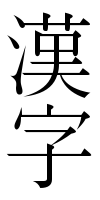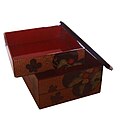Kanji
Kanji (漢字) is one of the three forms of Japanese writing. A kanji is an ideogram: that is, a type of simple picture. These are made to show a word's meaning. It is a symbol of an idea such as an object, thing or quality.
Kanji ideograms (or “characters”) were taken from Chinese characters,[1] and many changed over time. The word “kanji” means “Han characters” (i.e. “Chinese characters”).[2]
Kanji vs. kana
There are two other systems used to write in Japanese. These systems are called hiragana and katakana (together they are called “kana”). They show how a word is pronounced because each character stands for a syllable (a, ka, sa, ta etc.). Each kanji could also be written in kana, indeed they are in children’s books or books for foreigners learning Japanese.
Japanese can have many homophones for one pronunciation, e.g. kami can mean “god”, “hair”, "paper", or "upper stream". Since each words is made of the same syllables, they are written using the same kana (かみ in hiragana and カミ in katakana), but since they all have very different meanings, the kanji character for each word is quite different. The kanji for "god" is 神, the kanji for "hair" is 髪, the kanji for "paper" is 紙, and the kanji for "upper stream" is 上. However, each kanji character can have several different pronunciations, according to which meaning (which “reading”) is intended.
Kanji was originally written to look like what it means, thus the Japanese symbol for mouth is 口 (which is said as kuchi), and looks like a mouth. Another word, 山 (said as yama) means mountain. The Japanese have for many words. Many can be shown with just one kanji, but sometimes two kanji characters are combined to make new words, such as 山口 (yamaguchi), "mountain-mouth", meaning a cave. (It is also a surname and the name of a prefecture).
Kanji is often combined with hiragana to show the grammatical meaning of the word. In English this would be done with endings (e.g. “act” (the verb), “action” (the noun) etc.)
Kun-yomi vs. on-yomi
Most kanji characters can be pronounced at least two different ways according to whether the word is a native Japanese word (this is called the “kun” reading, or “kun-yomi”), or whether it came from Chinese (this called the “on” reading or “on-yomi”). Kanji that stand alone usually have kun-yomi, while kanji compound words usually have on-yomi. For example, 山 on its own is "yama" (the Japanese word for “mountain”). When it is combined with another word or name, it is pronounced "san" e.g. “Fuji-san” (Mount Fuji).
However, there are many exceptions to these patterns. For example, some native Japanese words with two or more kanji (usually proper nouns) use their kanji's kun-yomi, like 山口, which is pronounced "yama-guchi", even though the on-yomi for the kanji would be "san" and "kō" in that order. Sometimes, kanji only have on-yomi and have no kun-yomi. For example, the kanji 毒, which means "poison", only has the on-yomi "doku". Sometimes, compound words mix on-yomi and kun-yomi together. For example, the word 金色, which means "golden", is pronounced "kin-iro", in which the first kanji uses its on-yomi, and the second-kanji uses its kun-yomi. Sometimes, the kanji in certain compound words may not even use their kanji readings at all, but are used only to show the word's meaning. For example, the word 煙草 is pronounced "tabako", which means "tobacco" in English. This word was borrowed from Portuguese, and while the pronunciation of the word does not match either kanji, the meaning of the kanji are "smoke" and "grass" in that order, hinting at the word's meaning. There are even some words whose kanji can be used to only show a word's pronunciation and not its meaning. These are called ateji. For example, the word 亜米利加, which means "America", is pronounced "Amerika", but none of the kanji meanings have any obvious connection to America. However, words of the last kind are usually written in only katakana these days, though sometimes words like "sushi" are still written in ateji, like 寿司, because Chinese tourists will recognize the ateji more easily, since the word is written the same way in Chinese.
Number of kanji
Kanji characters are classed on the basis of how many brush strokes they are made of. The simplest kanji have one stroke and the most complex may have up to 30 strokes.
There are many different Kanji, the exact number is not known but it is around 50,000. However, not all 50,000 are taught in schools. The government of Japan has set up a 1,945 basic kanji list (Jōyō Kanji Archived 2013-01-02 at the Wayback Machine) that those learning the language need to know. They are the ones most commonly used in newspapers and magazines, along with street signs and store signs. Kanji takes many years to learn. By the end of his school years a pupil should know about 1,850 kanji. A university graduate would need to know about 3000. If someone does not know the kanji for a word, they can write it in kana and it will be understood, but it is usually not the proper way to write it, however kana can have many meanings for the same word, so unless the person writes in kanji, we will not know what they are saying. [3]
Kanji Media
Nihon Shoki (720 AD), considered by historians and archaeologists as the most complete extant historical record of ancient Japan, was written entirely in kanji.
A young woman practicing kanji. Ukiyo-e woodblock print by Yōshū Chikanobu, 1897.
An image that lists most jōyō-kanji, according to Halpern's KKLD indexing system, with kyo-iku kanji color-coded by grade level
References
- ↑ Taylor, Insup; Taylor, Maurice Martin (1995). Writing and literacy in Chinese, Korean, and Japanese. Amsterdam: John Benjamins Publishing Company. p. 305. ISBN 90-272-1794-7.
- ↑ Suski, P.M. (2011). The Phonetics of Japanese Language: With Reference to Japanese Script. p. 1. ISBN 9780203841808.
- ↑ "Why does Japanese writing need three different sets of characters?". JapanToday. Retrieved 31 October 2021.
- New Japanese-English Character Dictionary ed J Halpern Kenkyusha 1990
Other websites
- RomajiDesu Kanji Dictionary an easy to use Kanji dictionary with multiple radical and stroke order diagrams
- Kanji Explorer Archived 2007-10-26 at the Wayback Machine Browse Kanji and Jukugo
- Real Kanji Practice kanji using different typefaces
- Kanji alive, an interactive tool for learning kanji in wide use at schools and universities
- Japanese Kanji Tutorials and History





